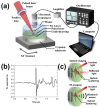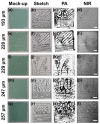Revealing Hidden Features in Multilayered Artworks by Means of an Epi-Illumination Photoacoustic Imaging System
- PMID: 34564109
- PMCID: PMC8472515
- DOI: 10.3390/jimaging7090183
Revealing Hidden Features in Multilayered Artworks by Means of an Epi-Illumination Photoacoustic Imaging System
Abstract
Photoacoustic imaging is a novel, rapidly expanding technique, which has recently found several applications in artwork diagnostics, including the uncovering of hidden layers in paintings and multilayered documents, as well as the thickness measurement of optically turbid paint layers with high accuracy. However, thus far, all the presented photoacoustic-based imaging technologies dedicated to such measurements have been strictly limited to thin objects due to the detection of signals in transmission geometry. Unavoidably, this issue restricts seriously the applicability of the imaging method, hindering investigations over a wide range of cultural heritage objects with diverse geometrical and structural features. Here, we present an epi-illumination photoacoustic apparatus for diagnosis in heritage science, which integrates laser excitation and respective signal detection on one side, aiming to provide universal information in objects of arbitrary thickness and shape. To evaluate the capabilities of the developed system, we imaged thickly painted mock-ups, in an attempt to reveal hidden graphite layers covered by various optically turbid paints, and compared the measurements with standard near-infrared (NIR) imaging. The obtained results prove that photoacoustic signals reveal underlying sketches with up to 8 times improved contrast, thus paving the way for more relevant applications in the field.
Keywords: artwork; cultural heritage; diagnostics; imaging; photoacoustic; underdrawings.
Conflict of interest statement
The authors declare no conflict of interest.
Figures





References
-
- Wang L.V., Wu H.-I. Biomedical Optics: Principles and Imaging. John Wiley and Sons; Hoboken, NJ, USA: 2012. pp. 283–293.
Grants and funding
LinkOut - more resources
Full Text Sources
Miscellaneous

